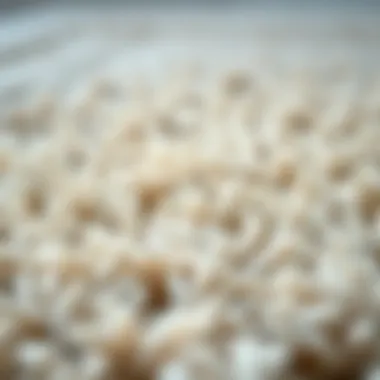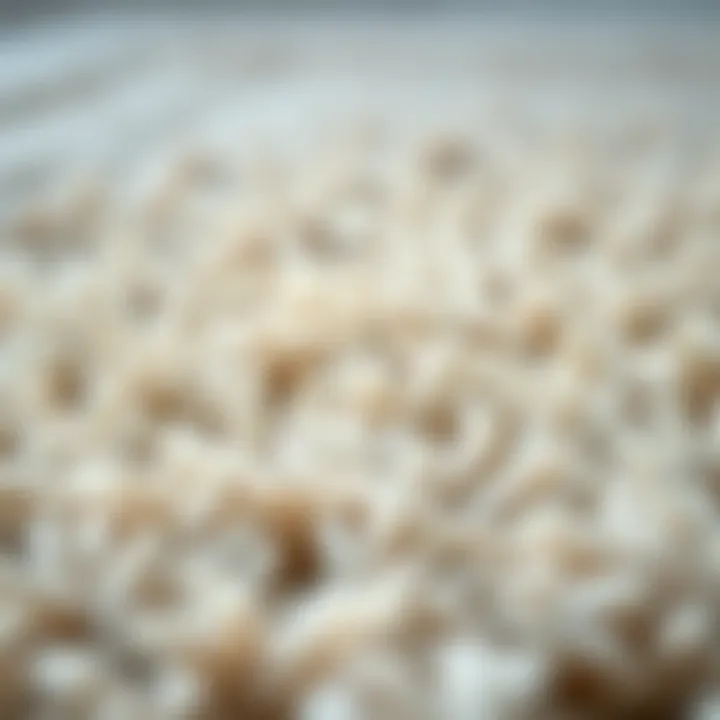Expert Tips for Cleaning Fluffy Rugs Effectively


Intro
Washing fluffy rugs isn't just a chore—it's an art form. For many homeowners, these soft masterpieces add warmth and texture to rooms but come with their own set of challenges when it comes to keeping them clean. Fluffy rugs, with their plush fibers and cozy feel, often demand careful handling. It's not as straightforward as throwing them into the washing machine; the type of rug, the material it's made of, and even the dirt embedded in it will dictate the best cleaning methods.
In this guide, we will dive headfirst into the world of fluffy rug maintenance. From understanding different varieties of fluffy rugs to the specifics of cleaning techniques, we'll explore it all. By the time you wrap your head around these insights, you'll feel empowered to tackle even the grimiest of rugs. Through careful consideration of cleaning products and methods, you'll keep your rugs looking fresh and inviting for years to come.
Let’s get started!
Understanding Fluffy Rugs
Fluffy rugs are more than just adornments for our floors; they contribute to the overall ambience of a room. Understanding the nuances of these rugs is crucial for proper maintenance and care. When you start to appreciate the diversity in fluffy rugs, it helps you make informed decisions about cleaning methods and longevity. With each type and material comes its own specific cleaning needs, which is a vital focus of this article.
Types of Fluffy Rugs
Shag rugs
Shag rugs are perhaps the most iconic representation of plush flooring. With their lengthy fibers, they provide not just visual appeal, but also a cushy surface underfoot. The key characteristic of shag rugs is their deeply tufted texture, allowing for a comfortable and laid-back vibe in any room.
This type of rug is popular because of its inviting warmth, perfect for living areas or cozy nooks. One unique feature of shag rugs is their height—long fibers can range from one inch to several inches. However, this can be a double-edged sword; while they’re soft to touch, they can trap dirt and dust, leading to more frequent cleaning.
Faux fur rugs
Faux fur rugs offer the luxurious feel of real fur without the ethical concerns often associated with animal products. Their standout characteristic is the softness, mimicking that cozy touch found in natural fur. Because of these qualities, faux fur rugs have gained popularity for achieving an upscale ambiance in interior design.
A significant advantage of faux fur rugs is their durability. They are easier to clean than their real fur counterparts and resist staining. However, careful maintenance is needed to avoid matting of the fibers over time.
Wool rugs
Wool rugs bring a level of sturdiness and timelessness to any decor setting. Known for their resilience, wool rugs can withstand high traffic areas better than others. The most compelling aspect of wool rugs is their natural insulating properties that keep spaces warm.
Additionally, they have a unique feature: they are naturally stain-resistant due to the lanolin found in wool fibers. Despite this, some find wool rugs difficult to clean, often requiring specialized cleaning methods or professional intervention, which can be a drawback for some homeowners.
Material Considerations
Nylon vs. Polyester
When considering materials for fluffy rugs, nylon and polyester frequently find themselves in the spotlight. Nylon is known for its strength and resilience, making it an excellent choice for areas that experience heavy foot traffic.
On the other hand, polyester offers vibrant colors and patterns that remain strong over time; it won’t fade like many other materials. For those wanting an undeniably soft feel, both materials grip attention, yet they come with their pros and cons. Nylon typically requires more committed cleaning efforts, while polyester can sometimes show wear and tear sooner than wool or other natural fibers.
Natural fibers
Natural fibers, such as cotton and jute, lend themselves to a unique aesthetic charm. They are biodegradable and tend to be more environmentally friendly compared to synthetic materials. The breathable nature of natural fibers ensures good airflow, making them a comfortable option for different spaces.
However, they can be more susceptible to stains and may not withstand heavy use like man-made options. In humid conditions, some natural fibers might also promote mold growth if not dried properly, which is something to consider.
Blended fabrics
Blended fabrics offer a middle ground between man-made and natural materials. By combining different fibers, manufacturers create rugs that gain the benefits of both worlds. Often, a blend will include wool with synthetic fibers like nylon, producing a rug that is plush yet durable.
One key characteristic of blended fabrics is versatility—these rugs can adapt to various aesthetic choices. They often come at a lower price point, making them accessible for many, yet the challenge can come in finding the right balance of softness and durability.
Preparing for the Washing Process
Washing a fluffy rug might seem as simple as tossing it in the washing machine and walking away, but that assumption couldn't be further from the truth. This section delves into the essential preparations that set the stage for a successful cleaning process. Proper preparation ensures that you avoid common pitfalls such as damaging the fabric or missing out on important steps that keep your rug looking vibrant and plush.
By arming yourself with the right tools and understanding the specifics of your rug's materials and manufacturer's recommendations, you are more likely to achieve a positive result.
Tools and Supplies Needed
Vacuum cleaner
A vacuum cleaner is your rug's first line of defense against dirt, dust, and debris. Think of it as the warm-up act before the main show begins. It helps to lift and loosen any particles trapped in the fibers, making the subsequent washing process more effective. A key characteristic of a good vacuum cleaner for fluffy rugs is its suction ability. Models with adjustable suction settings or specialized attachments for rugs can really make a difference.
Using a vacuum with a beater bar can be a double-edged sword. On one hand, it agitating the fibers and removing debris more efficiently, on the other, it can be a little rough on delicate materials. Always ensure you're on the right setting for your rug type.


Mild detergent
When it comes to cleaning solutions, sticking with a mild detergent is non-negotiable. These detergents are less likely to strip away the natural oils from fibers, which keeps the texture soft and plush. For a fuzzy rug, opting for a biodegradable or eco-friendly mild detergent can also be a beneficial choice.
The standout feature of a good mild detergent is its ability to break down dirt without causing damage. It's both efficient and gentle; two qualities that can have lasting impacts when cleaning your prized rugs.
Soft-bristle brush
A soft-bristle brush is like having a gentle hand at your disposal while cleaning. While the vacuum prepares the surface, this brush helps to work detergent deeper into the fibers without damaging them. It's vital for anyone aiming for that fluffiness after cleaning.
What sets the soft-bristle brush apart is its ability to reach into tight spaces where dirt might otherwise remain. The flexibility and gentleness of the bristles ensure that you won’t be tugging and pulling at the fibers, which could lead to wear over time.
Drying space
Once you've washed your fluffy rug, the drying process is equally important. A designated drying space allows your rug to air out without being constrained or crammed in a small area, which can lead to mildew and odors. An ideal drying space is well-ventilated and away from direct sunlight to prevent fading.
Moreover, an open area gives you the freedom to turn the rug periodically, ensuring even drying all around. Remember, patience is key here; the last thing you want is to put your rug back together when it's not completely dry.
Checking Manufacturer's Label
Before you dive into washing, your starting point should always be the manufacturer's label. This label acts as a guidebook. It helps in ensuring that you use the best methods and products, thus safeguarding the longevity of your rug. The recommendations here can make all the difference and often prevent costly mistakes.
Recommended cleaning methods
The recommended cleaning methods outlined on a label provide clarities straight from the horse's mouth. Different materials necessitate different approaches; you may find instructions for machine washing, hand washing, or even professional cleaning. Following these recommendations can simplify your life and help you avoid the guesswork.
What makes understanding recommended methods crucial is the insight into specific needs. For instance, a luxurious wool rug may require a hand-washing approach to maintain its texture and integrity, while a faux fur could be more machine-friendly.
Warnings and precautions
Warnings and precautions on the label serve as your red flags. Ignoring them could lead to unfortunate mishaps like unraveling threads or color bleeding. Knowing these precautions allows you to steer clear of common blunders, such as using hot water on a rug that can only handle cold.
Paying attention to these specifics, like what to avoid when cleaning, is essential. It’s a simple step that can keep your rug in top shape, saving you time and money in the long run.
Always remember: It’s better to check twice before you clean once!
Preparing adequately might take some extra time, but the end result—a beautifully clean and fluffy rug—will surely make it worth the effort.
Washing Machines vs. Hand Washing
When it comes to fluffy rugs, deciding between washing machines and hand washing can feel like a bit of a pickle. Each method has its own strengths and weaknesses, and the choice often hinges on your specific rug type and your overall cleaning goals. Knowing the ins and outs of both methods can save you a headache down the line.
When to Use a Washing Machine
Size and Weight Limitations
One of the first things to ponder about using a washing machine is the size and weight limitations of your rug. Not all fluffy rugs fit into the drum of a washing machine gracefully. If your rug is on the larger side, it may lead to uneven washing or worse, damage to your machine. Generally, most home washers can handle smaller shag or faux fur rugs quite well, but for big wool rugs or multi-layered designs, hand washing is often the safer bet.
This choice becomes beneficial because it can prevent potential issues like jamming or overloading the machine. Think of it this way: just because it looks like it fits, doesn’t mean it will fit without causing strain. A clear benefit here is that if your rug is within the size limit, the machine can save you time and physical effort compared to scrubbing by hand.
Suitable Materials
The suitable materials for machine washing play a vital role too. Materials like nylon or polyester fluff, which are more synthetic and resilient, typically hold up well in a washing machine. However, items made from natural fibers, such as wool or cotton, may be less compatible due to their propensity to shrink or collect lint in a washing machine. Those materials often require tender loving care through hand washing.
The main advantage of using a machine for suitable materials is the efficiency of deep cleaning. However, if you try to slip a highly delicate, natural-fiber rug into the wash, you might end up with a shrunken version of what you once had.
The Hand Washing Process
Creating a Cleaning Solution
If you're leaning toward hand washing, the creating a cleaning solution stage can't be skipped. This is where the magic really starts. A mild detergent mixed with lukewarm water creates a safe environment for your rug, ensuring that the fibers maintain their structure and fluffiness after a good scrub. It’s imperative to avoid strong chemicals, as they may cause fading or disintegration of those plush fibers.
One highlight of this approach is that it tailors the cleaning solution specifically to your rug's needs. Although it may take longer, the careful attention can lead to more satisfactory results without risking damage. Plus, making your own solution can be a resourceful way to save a few bucks in the long run.
Gentle Scrubbing Techniques
Finally, let’s touch on gentle scrubbing techniques. It’s easy to go overboard when you have a dirt-laden rug, but remember, moderation is key. Using a soft-bristle brush or even your hands, you can delicately work through stains without causing distress to the fibers.


This technique is favored because it maintains the rug's integrity while effectively lifting dirt and grime. The challenge lies in balancing efficacy with gentleness—too much vigor, and you risk breaking down the fibers. Being aware of how much pressure you’re applying can change the entire cleaning dynamic.
Key Point: Always undertake a test scrub in a less visible area to check how the fibers respond before diving into the main event!
In summary, whether to opt for a washing machine or go for a good old-fashioned hand wash depends considerably on the characteristics of your fluffy rug. Understanding material compatibility, size constraints, and the right cleaning methods—be it through machine or manual work—will ensure that your rugs continue to shine in their full, vibrant beauty.
Drying and Maintaining Fluffy Rugs
Taking care of fluffy rugs is more than just the initial washing; it’s about ensuring they dry properly and remain well-maintained over time. The drying process is crucial. If one doesn't dry their fluffy rugs effectively, it can lead to problems like mold growth and unpleasant odors, not to mention that it can ruin the comfort and look of the rug. This section dives into the best practices for drying and maintaining these rugs, addressing techniques and ongoing care that keep them in top shape.
Drying Techniques
Air drying vs. machine drying
When it comes to drying fluffy rugs, the debate between air drying and machine drying often pops up. Air drying is usually the preferred method, especially for delicate materials. It’s like letting nature do its work; fresh air and gentle sunshine can work wonders without risking damage to fibers. However, machine drying might seem tempting with its quick results. It dries rugs faster and is convenient, particularly for those who may not have the luxury of time.
A key characteristic of air drying is that it gives fibers a chance to maintain their natural fluffiness without the risk of shrinking or tangling, which machine drying can often cause. Machine drying can save you time, but it indeed comes with its risks of high heat damaging synthetic materials, especially if the rug isn’t made for that kind of treatment.
In summary, air drying is often the more beneficial choice, helping preserve the rug’s integrity and fluffiness. If you choose machine drying, it’s vital to check each rug’s care label beforehand to avoid making a costly mistake.
Using towels to absorb moisture
Another important aspect of the drying process is using towels to absorb moisture. This technique can be quite effective in minimizing drying time, especially when combined with air drying. Just grab a few clean, absorbent towels, lay them over the wet rug, and gently press down to soak up excess water. This method allows you to avoid saturating your rug with water and reduces the time it needs to air dry.
The beauty of this technique lies in its simplicity and dual benefit: your rug dries faster while avoiding water pooling, which can later lead to mold. However, there’s a small drawback—this method can be labor-intensive, requiring a bit of elbow grease. Nonetheless, using towels effectively ensures that the delicate fibers of fluffy rugs remain intact and soft.
Post-Washing Maintenance
Maintaining a fluffy rug involves a consistent routine that goes beyond just washing. It’s about setting up practices that safeguard your investment and preserve its aesthetics. Two main aspects come into play here: regular vacuuming and effective spot cleaning methods.
Regular vacuuming
Regular vacuuming is essential for keeping fluffy rugs looking their best. Dust, dirt, and pet hair can pile up quickly, dulling the vibrancy of the rug and making it look worn. Vacuuming helps lift up dirt trapped within fibers, preventing long-term damage. An important characteristic of regular vacuum maintenance is that it doesn’t just clean—it also extends the life of the rug. The more often you vacuum, the less dirt penetrates deep into the fabric, which can lead to discoloration or damage over time.
While vacuums are a fantastic tool for maintaining overall cleanliness, one must be careful in choosing the right settings. For instance, using a suitable attachment or keeping the vacuum on a gentle setting is wise to avoid snagging or pulling the rug fibers. Simply put, regular vacuuming is a beneficial practice that enhances both cleanliness and durability.
Spot cleaning methods
Spot cleaning is another crucial component of post-washing maintenance. Life happens, and sometimes spills are unavoidable. What matters is how one tackles those spots. Quick attention to spills using the right cleaning solution can prevent staining from setting.
The unique aspect of spot cleaning lies in its targeted approach. Instead of cleaning the entire rug, you focus on those pesky marks, which saves time and effort while minimizing potential damage. It’s beneficial because, often, you don’t have to wash the whole rug when just a small area needs attention. However, keep in mind that using the wrong cleaner can cause harm. Always ensure that any product used is safe for your rug’s material, as some chemicals can strip their natural softness or color.
"A stitch in time saves nine"—this holds true for fluffy rugs. Timely spot cleaning can save a lot of hassle down the road.
Common Mistakes to Avoid
It can be tempting to rush through cleaning fluffy rugs, but doing so often leads to mistakes that can compromise their appearance and durability. Understanding these common pitfalls is crucial to ensure your rugs not only maintain their aesthetic appeal but also have a prolonged lifespan. Taking the time to educate oneself about these traps will save future headaches and expenses.
Using Harsh Chemicals
Impact on fibers
When it comes to cleaning fluffy rugs, using harsh chemicals might seem like a shortcut to achieving a pristine look. However, such chemicals can severely damage the fibers, causing them to lose softness and become brittle over time. For instance, bleach, while powerful in eliminating stains, can lead to frizzling and breaking of delicate rug fibers.
A key characteristic of softer, more gentle cleaning agents is their ability to maintain the integrity of the material. Oftentimes, opting for a mild detergent is smarter, keeping your rug plush and inviting. The unique feature here is that mild detergents clean effectively without stripping essential oils from the fibers, protecting their overall structure.
Risk of discoloration
In addition to impacting the fibers, harsh chemicals carry a significant risk of discoloration. A vibrant rug can quickly become dull or, worse, exhibit unwanted splotches of faded color if exposed to strong cleaning agents. The key characteristic that puts this at the forefront of cleaning considerations is that each type of rug material reacts differently. When you use unsuitable products, you open the door to discoloration which may not only ruin your rug but also necessitate expensive replacements.
Natural cleansers, while sometimes slower acting, do not come with the baggage of detrimental side effects. This makes them a more wise choice in most cases, allowing the rug to retain its hue and charm.
Improper Drying
Consequences of dampness


After washing a fluffy rug, attention to proper drying is equally important. Leaving your rug damp can lead to a host of issues, like odor retention, and even warping of the fibers. When moisture lingers, it's an invitation for trouble—both for the rug and the home environment. The consequence here is not just about an unpleasant scent; damp rugs can draw pests and promote an increase in allergens in living spaces.
What makes proper drying a critical step is the unique way it restores the plush nature of your rug. Proper air circulation, potentially complemented by low heat from a fan or air conditioner, can eliminate residual moisture and maintain the rug's softness, keeping it looking fresh.
Mold and mildew growth
One of the more sinister outcomes of improper drying is the growth of mold and mildew. These unwelcome guests thrive in damp environments and can wreak havoc on your rug's fibers, not to mention present serious health risks. The risk of mold and mildew growth is all the more pronounced in humid conditions, where rugs tend to retain moisture longer.
Mold isn’t just a visual nuisance; it can deteriorate fibers and lead to irreversible damage. Moreover, the unique feature of mold is that it often hides within the fibers, making it virtually undetectable until it has become a real problem. Therefore, ensuring ample drying time, preferably in a well-ventilated area, protects against these risks, preserving the rug’s beauty and health benefits for households.
Proper care in washing and drying avoids common pitfalls, enabling your fluffy rugs to remain a source of comfort and style in your space.
Alternative Cleaning Methods
When it comes to maintaining the fidelity and vibrance of fluffy rugs, exploring alternative cleaning methods can offer unprecedented benefits. Standard washing techniques may not always suffice, particularly for rugs that have accumulated significant wear or specific types of grime. This section delves into both steam cleaning and professional cleaning services, outlining their nuances, benefits, and considerations to ensure a thorough understanding for the reader.
Steam Cleaning
Benefits and drawbacks
Steam cleaning is a technique that utilizes high-temperature steam to penetrate fabric fibers deeply. One might consider this method due to several reasons. Primarily, the ability of steam cleaning to disinfect and eliminate allergens without the use of harsh chemicals is noteworthy. This keeps the rug not only looking good but also ensures a healthier environment at home. On the flip side, steam cleaning isn't without its downsides. Certain rugs, especially those made of delicate fibers, may react poorly to such high heat. Therefore, it's paramount to assess the material before proceeding.
"Steam cleaning can be a game-changer for maintaining fluffy rugs, but always remember to check the tags. "
Furthermore, while steam cleaning can remove stubborn stains, it sometimes requires a more extended drying period, which can be tricky if there is high humidity in the air. It's a balancing act of pros and cons.
Best practices
Adopting effective best practices while engaging in steam cleaning ensures optimal results. Before attempting to clean, one should vacuum the rug thoroughly. Once you've done that, it is advisable to test the steam on a small, inconspicuous area first. This helps to ensure that the fibers won’t be damaged or altered in color. Another key practice is to adjust the steam settings according to the fabric—higher settings for sturdier materials and lower for more delicate ones.
While steam cleaning can be a highly effective option, knowing when and how to apply it is crucial. A proper follow-up with ventilation will help expedite drying times, keeping the rug fluffy instead of damp. Taking these precautions can significantly enrich the experience of maintaining a fluffy rug's look and feel.
Professional Cleaning Services
When to consider hiring professionals
Sometimes, despite the best efforts and intentions, cleaning can become overwhelming. Hiring professionals can take the stress off hands. Usually, this is wise when the rug has significant stains or odors that simply won’t budge. If the rug is an investment piece, such as an authentic Persian or a vintage shag rug, using professionals ensures that the cleaning is worth the expense.
Professionals often employ specialized equipment and knowledge that homeowners may not possess. Additionally, their understanding of various materials and textures aids in preserving the rug's quality, something many enthusiasts deeply value.
Evaluating service options
When it comes to evaluating service options, it's essential to conduct thorough research. Not every service is equal, and their approaches can vary widely. First, check reviews and testimonials from previous clients. A reliable service typically has a solid reputation and feedback to back it up.
Moreover, inquire about the techniques they use. Are they relying on eco-friendly products or harsh chemicals? Understanding their methods can help in making an informed choice. Lastly, obtaining several quotes allows one to discern what fits into your budget while still providing quality service.
Finale
In wrapping up this comprehensive exploration of washing fluffy rugs, it becomes clear that maintaining these items goes beyond mere cleaning. It involves understanding the unique properties of the materials involved, the proper techniques for care, and the little nuances that can make a world of difference in their longevity and appearance. With a focus on techniques, come effective cleaning products, and maintenance advice, this guide equips you with essential insights that ensure your fluffy rugs not only survive the rigors of daily life but thrive in your living space.
Being informed allows homeowners to avoid common pitfalls, ensuring their cherished rugs remain vibrant and soft. Each section discussed illustrates the importance of tailored approaches to cleaning, highlighting that what works for one type might not suit another. The right methods can make all the difference. The commitment to understanding your carpeting can help evade costly mistakes and prolong the need for replacements.
A careful analysis of how to address cleaning challenges makes a strong case for regular maintenance. Overall, taking the time to properly care for your fluffy rugs pays dividends in comfort, aesthetics, and even health. After all, a clean rug isn’t just a matter of looks—it’s about creating a welcoming and healthy environment within your home.
Recap of Key Points
To help solidify your understanding, here are the main points discussed throughout this guide:
- Types of Fluffy Rugs: Understanding the various types, like shag and faux fur, sets the stage for effective cleaning.
- Preparation Matters: Always check the label for care instructions before beginning. The right tools make a world of difference.
- Washing Techniques: The choice between machines or hand washing hinges on the rug's material and size.
- Drying Techniques: Proper drying is crucial to prevent mold growth and maintaining shape.
- Common Mistakes: Avoiding harsh chemicals and improper drying can save you from potential mishaps.
- Alternative Methods: Options like steam cleaning offer flexibility, depending on your preferences and resources.
This roundup of insights helps solidify your preparation for proper rug care. Each point serves as a foundation for better decision-making when it comes to washing your fluffy rugs.
Maintaining Aesthetic Appeal
Beyond just cleanliness, the aesthetic appeal of fluffy rugs directly contributes to your home’s atmosphere. Regular maintenance keeps colors vibrant and textures plush. While vacuuming and spot cleaning are just routine tasks, they play a vital role in the overall upkeep that influences how inviting your space feels.
Here are some approaches to keep your rugs looking their best:
- Routine Vacuuming: Regularly dusting off your rugs prevents stains and buildup. Even a quick once-over each week can work wonders.
- Spot Cleaning: Acting swiftly on spills can save your rugs from permanent marks. Use a gentle detergent and dab rather than rub.
- Rotate Rugs: Changing the position of your rugs can prevent uneven wear and maintain their structure.
- Seasonal Deep Cleaning: Every few months, committing to a deeper wash or steam clean can reinvigorate fibers and feels.
- Protective Sprays: For those in high-traffic areas, consider using a fabric protector to minimize stains and fading.
By weaving these habits into your cleaning routine, your fluffy rugs will not only serve their purpose but also enhance your home’s charm and comfort. This attention to detail feeds into a larger narrative of self-care within your living space.
For further reading, explore resources like Wikipedia, or Britannica for more insights on home maintenance.



